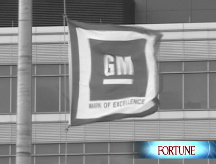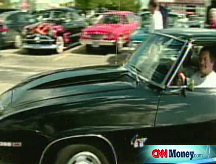Dragging GM and Chrysler to the altar
The two embattled automakers say they can make it as stand alone companies, but government officials might decide the best solution is a merger.
NEW YORK (CNNMoney.com) -- Federal loans kept General Motors and Chrysler LLC out of bankruptcy in December.
Now as both companies try to prove they are worthy of keeping those loans -- and perhaps getting even more -- there are some who think the government might try to bring the two companies together in a corporate "arranged marriage."
Kimberly Rodriguez, head of the global auto practice at Grant Thornton Advisory Services, said that such a deal would make more sense for Chrysler than for GM (GM, Fortune 500), but that it also might be the best alternative for government officials trying to keep as many Chrysler workers and U.S. suppliers on the job as possible.
"It's a better option than Chrysler trying to survive as a stand alone company," she said. "It's not a great solution. But if your solution set is so imperfect, it's not a bad option."
One of the things that derailed merger talks between the two companies last fall was the fact that it would cost more money upfront to combine them than to try to go it alone. Closing excess factories and dealerships and combining operations would cost billions of dollars neither have right now..
Treasury has already loaned the two companies $17.4 billion and the two requested up to $21.6 billion more in the viability plans they submitted to the government earlier this week.
Rodriguez said she thinks the government will at least consider whether it would be better to loan them even more money so they can combine and emerge as a stronger company down the road.
"You have to decide how much money to throw at the thing," she said.
Federal officials charged with overseeing the bailout of General Motors and Chrysler LLC met as a group for the first time Friday to start weighing the turnaround plans.
Buried deep within those two 100-plus page plans was the suggestion that the companies might be best off if they were combined into one.
Chrysler went so far as to quote analyst estimates that such a combination could produce between $40 billion to $58 billion in improved profits for the two companies between now and 2016.
The Chrysler plan said that "there exists further benefits from U.S. consolidation but no clear action path with GM." Instead, the company is now focused on trying to complete an alliance it is studying with Italian automaker Fiat.
"We knew we would get asked questions about our earlier discussions related to proposed alliances, so we decided to be very upfront and put it all in the presentation," said Chrysler spokesman Stuart Schorr. But he acknowledged that conceptually, a deal with GM provided Chrysler the greatest cost savings.
GM also says in its plan that it is not pursuing any kind of combination with Chrysler. It also seemed more dismissive of the idea than Chrysler.
"The recent, rapid deterioration in economic conditions have made investment in the up-front costs associated with such consolidations an obviously lesser priority than addressing the immediate restructuring needs of General Motors," the company said in its plan.
But GM spokesman Tom Wilkinson said GM is interested in hearing suggestions from the federal auto task force for the best course for the company to pursue.
"I think there will be some great discussions there," he said. "We want to continue to have this be a constructive process for all concerned."
Both companies have announced plans to shrink further in response to the weaker U.S. auto sales outlook.
Chrysler laid out plans to cut about 3,000 addition U.S. workers, or about 6% of its remaining staff. GM said it plans to reduce its U.S. work force by about 20,000 workers this year, and close five additional plants by 2012, on top of the 12 it had already said it expected to shutter. Each have offered buyouts to all their remaining hourly staff.
And the smaller the two companies get, the easier it might be to combine them, said David Cole, chairman of the Center for Automotive Research.
"You're kind of setting it up to partner with somebody," said Cole. ![]()



